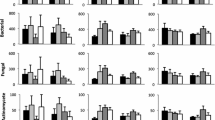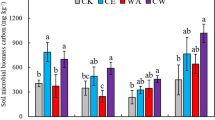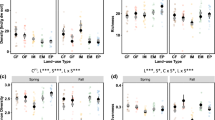Abstract
Global climate warming is one of the key forces driving plant community shifts, such as range shifts of temperate species into boreal forests. As plant community shifts are slow to observe, ecotones, boundaries between two ecosystems, are target areas for providing early evidence of ecological responses to warming. The role of soil fauna is poorly explored in ecotones, although their positive and negative effects on plant species can influence plant community structure. We studied nematode communities in response to experimental warming (ambient, +1.7, +3.4 °C) in soils of closed and open canopy forest in the temperate-boreal ecotone of Minnesota, USA and calculated various established nematode indices. We estimated species-specific coverage of understory herbaceous and shrub plant species from the same experimental plots and tested if changes in the nematode community are associated with plant cover and composition. Individual nematode trophic groups did not differ among warming treatments, but the ratio between microbial-feeding and plant-feeding nematodes increased significantly and consistently with warming in both closed and open canopy areas and at both experimental field sites. The increase in this ratio was positively correlated with total cover of understory plant species, perhaps due to increased predation pressure on soil microorganisms causing higher nutrient availability for plants. Multivariate analyses revealed that temperature treatment, canopy conditions and nematode density consistently shaped understory plant communities across experimental sites. Our findings suggest that warming-induced changes in nematode community structure are associated with shifts in plant community composition and productivity in the temperate-boreal forest ecotones.



Similar content being viewed by others
References
Bakonyi G, Nagy P, Kovács-Láng E et al (2007) Soil nematode community structure as affected by temperature and moisture in a temperate semiarid shrubland. Appl Soil Ecol 37:31–40. doi:10.1016/j.apsoil.2007.03.008
Bardgett RD, Chan KF (1999) Experimental evidence that soil fauna enhance nutrient mineralization and plant nutrient uptake in montane grassland ecosystems. Soil Biol Biochem 31:1007–1014. doi:10.1016/S0038-0717(99)00014-0
Beck T, Joergensen R, Kandeler E et al (1997) An inter-laboratory comparison of ten different ways of measuring soil microbial biomass C. Soil Biol Biochem 29:1023–1032
Beckage B, Osborne B, Gavin DG et al (2008) A rapid upward shift of a forest ecotone during 40 years of warming in the Green Mountains of Vermont. Proc Natl Acad Sci USA 105:4197–4202. doi:10.1073/pnas.0708921105
Bergh J, Linder S (1999) Effects of soil warming during spring on photosynthetic recovery in boreal Norway spruce stands. Glob Chang Biol 5:245–253
Bever JD (2002) Negative feedback within a mutualism: host-specific growth of mycorrhizal fungi reduces plant benefit. Proc Biol Sci 269:2595–2601. doi:10.1098/rspb.2002.2162
Bever J, Westover K, Antonovics J (1997) Incorporating the soil community into plant population dynamics: the utility of the feedback approach. J Ecol 85:561–573
Blankinship JC, Niklaus PA, Hungate BA (2011) A meta-analysis of responses of soil biota to global change. Oecologia 165:553–565. doi:10.1007/s00442-011-1909-0
Bongers T (1999) The maturity index, the evolution of nematode life history traits, adaptive radiation and cp-scaling. Plant Soil 212:13–22
Bongers T, Bongers M (1998) Functional diversity of nematodes. Appl Soil Ecol 10:239–251
Bongers T, van der Meulen H, Korthals G (1997) Inverse relationship between the nematode maturity index and plant parasite index under enriched nutrient conditions. Appl Soil Ecol 6:195–199. doi:10.1016/S0929-1393(96)00136-9
Brzostek ER, Blair JM, Dukes JS et al (2012) The effect of experimental warming and precipitation change on proteolytic enzyme activity: positive feedbacks to nitrogen availability are not universal. Glob Chang Biol 18:2617–2625. doi:10.1111/j.1365-2486.2012.02685.x
Chen I-C, Hill JK, Ohlemüller R et al (2011) Rapid range shifts of species associated with high levels of climate warming. Science 333:1024–1026. doi:10.1126/science.1206432
Conant RT, Ryan MG, Ågren GI et al (2011) Temperature and soil organic matter decomposition rates—synthesis of current knowledge and a way forward. Glob Chang Biol 17 doi: 10.1111/j.1365-2486.2011.02496.x
Davidson EA, Janssens IA (2006) Temperature sensitivity of soil carbon decomposition and feedbacks to climate change. Nature 440:165–173. doi:10.1038/nature04514
De Deyn GB, Raaijmakers CE, Zoomer HR et al (2003) Soil invertebrate fauna enhances grassland succession and diversity. Nature 422:711–713. doi:10.1038/nature01548
Eisenhauer N (2012) Aboveground–belowground interactions as a source of complementarity effects in biodiversity experiments. Plant Soil 351:1–22. doi:10.1007/s11104-011-1027-0
Eisenhauer N, Migunova VD, Ackermann M et al (2011) Changes in plant species richness induce functional shifts in soil nematode communities in experimental grassland. PLoS One 6:e24087. doi:10.1371/journal.pone.0024087
Eisenhauer N, Cesarz S, Koller R et al (2012) Global change belowground: impacts of elevated CO2, nitrogen, and summer drought on soil food webs and biodiversity. Glob Chang Biol 18:435–447. doi:10.1111/j.1365-2486.2011.02555.x
Engelkes T, Morriën E, Verhoeven KJF et al (2008) Successful range-expanding plants experience less above-ground and below-ground enemy impact. Nature 456:946–948. doi:10.1038/nature07474
Ferris H, Bongers T (2009) Indices Developed Specifically for Analysis of Nematode Assemblages. In: Wilson MJ, Kakouli-Duarte T (eds) Nematodes as environmental indicators. CABI, UK, pp 124–145
Ferris H (2010) Form and function: metabolic footprints of nematodes in the soil food web. Eur J Soil Biol 46:97–104. doi:10.1016/j.ejsobi.2010.01.003
Fisichelli NA, Frelich LE, Reich PB (2013a) Climate and interrelated tree regeneration drivers in mixed temperate-boreal forests. Landsc Ecol 28:149–159. doi:10.1007/s10980-012-9827-z
Fisichelli NA, Frelich LE, Reich PB (2013b) Temperate tree expansion into adjacent boreal forest patches facilitated by warmer temperatures. Ecography 36:001–010
Frelich LE, Peterson RO, Dovciak M et al (2012) Trophic cascades, invasive species and body-size hierarchies interactively modulate climate change responses of ecotonal temperate-boreal forest. Philos Trans R Soc B Biol Sci 367:2955–2961. doi:10.1098/rstb.2012.0235
Grandpré L, Boucher D, Bergeron Y, Gagnon D (2011) Effects of small canopy gaps on boreal mixedwood understory vegetation dynamics. Community Ecol 12:67–77. doi:10.1556/ComEc.12.2011.1.9
Gray A, Spies T, Easter M (2002) Microclimatic and soil moisture responses to gap formation in coastal Douglas-fir forests. Can J For Res 343:332–343. doi:10.1139/X01-200
Harrington R, Woiwod I, Sparks T (1999) Climate change and trophic interactions. Trends Ecol Evol 14:146–150
Ingham R, Trofymow J, Ingham E, Coleman D (1985) Interactions of bacteria, fungi, and their nematode grazers: effects on nutrient cycling and plant growth. Ecol Monogr 55:119–140
Irshad U, Villenave C, Brauman A, Plassard C (2011) Grazing by nematodes on rhizosphere bacteria enhances nitrate and phosphorus availability to Pinus pinaster seedlings. Soil Biol Biochem 43:2121–2126. doi:10.1016/j.soilbio.2011.06.015
Kardol P, Cregger MA, Campany CE, Classen AT (2010) Soil ecosystem functioning under climate change: plant species and community effects. Ecology 91:767–781
Kimball B (2005) Theory and performance of an infrared heater for ecosystem warming. Glob Chang Biol 11:2041–2056. doi:10.1111/j.1365-2486.2005.01028.x
Klironomos JN (2002) Feedback with soil biota contributes to plant rarity and invasiveness in communities. Nature 417:67–70. doi:10.1038/417067a
Komonen A, Penttila R, Lindgren M, Hanski I (2000) Forest fragmentation truncates a food chain based on an old-growth forest bracket fungus. Oikos 90:119–126. doi:10.1034/j.1600-0706.2000.900112.x
Leithead MD, Anand M, Silva LCR (2010) Northward migrating trees establish in treefall gaps at the northern limit of the temperate-boreal ecotone, Ontario, Canada. Oecologia 164:1095–1106. doi:10.1007/s00442-010-1769-z
Li Q, Bai H, Liang W et al (2013) Nitrogen addition and warming independently influence the belowground micro-food web in a temperate steppe. PLoS One 8:e60441. doi:10.1371/journal.pone.0060441
Lin D, Xia J, Wan S (2010) Climate warming and biomass accumulation of terrestrial plants: a meta-analysis. New Phytol 188:187–198. doi:10.1111/j.1469-8137.2010.03347.x
Magurran AE (2004) Measuring biological diversity. Blackwell Science Ltd.
Martius C, Höfer H, Garcia MVB et al (2004) Microclimate in agroforestry systems in central Amazonia: does canopy closure matter to soil organisms? Agrofor Syst 60:291–304. doi:10.1023/B:AGFO.0000024419.20709.6c
Morriën E, Duyts H, Van der Putten WH (2012) Effects of native and exotic range-expanding plant species on taxonomic and functional composition of nematodes in the soil food web. Oikos 121:181–190. doi:10.1111/j.1600-0706.2011.19773.x
Neher DA (2010) Ecology of plant and free-living nematodes in natural and agricultural soil. Annu Rev Phytopathol 48:371–394. doi:10.1146/annurev-phyto-073009-114439
Nunes JS, Araujo SF, Nunes PL, Lima LM, Carneiro RFV, Salviano C, Tsai SM (2012) Impact of land degradation on soil microbial biomass and activity in Northeast Brazil. Pedosphere 22:88–95. doi:10.1016/S1002-0160(11)60194-X
Pinheiro J, Bates D, DebRoy S et al (2013) nlme: linear and nonlinear mixed effects models. R package version 3 1–108
R Development Core Team (2012) R: a language and environment for statistical computing. R Foundation for Statistical Computing, Vienna, Austria
Rodríguez-García E, Bravo F, Spies TA (2011) Effects of overstory canopy, plant–plant interactions and soil properties on Mediterranean maritime pine seedling dynamics. For Ecol Manage 262:244–251. doi:10.1016/j.foreco.2011.03.029
Ruess L (1995) Studies on the nematode fauna of an acid forest soil: spatial distribution and extraction. Nematology 41(41):229–239
Ruess L, Michelsen A, Schmidt I, Jonasson S (1999) Simulated climate change affecting microorganisms, nematode density and biodiversity in subarctic soils. Plant Soil 212:63–73
Sahani U, Behera N (2001) Impact of deforestation on soil physicochemical characteristics, microbial biomass and microbial activity of tropical soil. L Degrad Dev 12:93–105. doi:10.1002/ldr.429
Scheu S (1992) Automated measurement of the respiratory response of soil microcompartments: active microbial biomass in earthworm faeces. Soil Biol Biochem 24:1–6
Singh BK, Bardgett RD, Smith P, Reay DS (2010) Microorganisms and climate change: terrestrial feedbacks and mitigation options. Nat Rev Microbiol 8:779–790. doi:10.1038/nrmicro2439
Stoate TN (1945) The use of a volume equation in pine stands. Aust For 9:48–52. doi:10.1080/00049158.1945.10675220
Tylianakis JM, Didham RK, Bascompte J, Wardle DA (2008) Global change and species interactions in terrestrial ecosystems. Ecol Lett 11:1351–1363. doi:10.1111/j.1461-0248.2008.01250.x
Valladares G, Cagnolo L, Salvo A (2012) Forest fragmentation leads to food web contraction. Oikos 121:299–305. doi:10.1111/j.1600-0706.2011.19671.x
Van Dam NM (2009) Belowground herbivory and plant defenses. Annu Rev Ecol Evol Syst 40:373–391. doi:10.1146/annurev.ecolsys.110308.120314
Van der Putten WH (2012) Climate change, aboveground-belowground interactions, and species’ range shifts. Annu Rev Ecol Evol Syst 43:365–383. doi:10.1146/annurev-ecolsys-110411-160423
Van der Putten WH, Macel M, Visser ME (2010) Predicting species distribution and abundance responses to climate change: why it is essential to include biotic interactions across trophic levels. Philos Trans R Soc Lond B Biol Sci 365:2025–2034. doi:10.1098/rstb.2010.0037
Van der Stoel CD, van der Putten WH, Duyts H et al (2002) Development of a negative plant-soil feedback in the expansion zone of the clonal grass Ammophila arenaria following root formation and nematode colonization. J Ecol 90:978–988. doi:10.1046/j.1365-2745.2002.00727.x
Wasilewska L (1997) Soil invertebrates as bioindicators, with special reference to soil-inhabiting nematodes. Russ J Nematol 5:113–126
Wiegmann SM, Waller DM (2006) Fifty years of change in northern upland forest understories: identity and traits of “winner” and “loser” plant species. Biol Conserv 129:109–123. doi:10.1016/j.biocon.2005.10.027
Yeates G (1999) Effects of plants on nematode community structure. Annu Rev Phytopathol 37:127–149
Yeates GW, Bongers T, De Goede RG et al (1993) Feeding habits in soil nematode families and genera-an outline for soil ecologists. J Nematol 25:315–331
Acknowledgments
We thank Cindy Buschena for the logistic help. We also thank Winfried Voigt for his suggestions in multivariate analysis. Nico Eisenhauer acknowledges funding by the Deutsche Forschungsgemeinschaft (DFG; Ei 862/1). Madhav P. Thakur and Nico Eisenhauer acknowledge funding by the DFG in the framework of the Emmy Noether research group (Ei 862/2). The B4WarmED project has been funded by the US Department of Energy (grant no. DE-FG02-07ER64456), the College of Food, Agricultural and Natural Resource Sciences at the University of Minnesota, and the Minnesota Environment and Natural Resources Trust Fund. We acknowledge helpful reviewer comments which improved our paper considerably.
Author information
Authors and Affiliations
Corresponding author
Additional information
Communicated by Roland A. Brandl.
Electronic supplementary material
Below is the link to the electronic supplementary material.
Rights and permissions
About this article
Cite this article
Thakur, M.P., Reich, P.B., Fisichelli, N.A. et al. Nematode community shifts in response to experimental warming and canopy conditions are associated with plant community changes in the temperate-boreal forest ecotone. Oecologia 175, 713–723 (2014). https://doi.org/10.1007/s00442-014-2927-5
Received:
Accepted:
Published:
Issue Date:
DOI: https://doi.org/10.1007/s00442-014-2927-5




